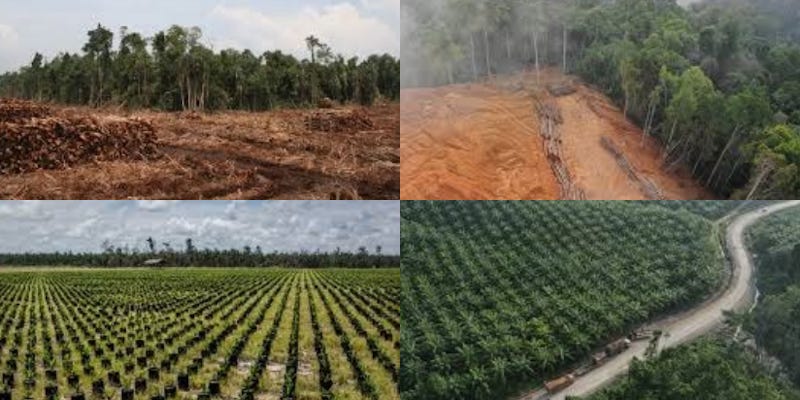New report finds that Indonesia’s claim of 90% reduction of deforestation since 2016 is based on “cherry picking” and “exaggerates the decline”
While deforestation has fallen, serious threats remain.

In 2015, devastating fires burned through huge areas of Indonesia’s forests. The deforestation peaked in 2016, with much of the primary forest loss to fire in 2016 a result of the burning in 2015. The deforestation was not visible on satellite images in 2015 because of the smoke from the fires.
The smoke is estimated to have caused about 100,000 premature deaths.
In 2016, almost 1 million hectares of primary forest was lost, according to Global Forest Watch.
Since 2015-2016, deforestation in Indonesia has fallen. However, by exactly how much the rate of deforestation has reduced is contested.
The Norwegian University of Life Sciences recently published a report looking at the reduction of Indonesia’s deforestation over the past decade. Written by Arild Angelsen, Ahmad Dermawan, and Malte Ladewig, the report finds that,
Several data sets on deforestation or tree cover loss are available, with quite different primary data sources and forest/deforestation definitions. This creates a wide range of figures, opening for cherry picking and selective uses.
The report looks at a series of factors that could explain the reduction in deforestation, including government policies, corporate self-regulation, civil society pressure, commodity prices, and forest scarcity.
“Forest scarcity” refers to the fact that in some high-deforestation areas, most of the forest has already gone. As a result, deforestation inevitably slows down. The researchers’ statistical analysis suggests that as much as one-third of the reduction in deforestation is a result of forest scarcity.
The data sets do not match
The researchers carried out a literature review, interviewed 32 experts in Indonesia, and did statistical analyses of quantitative data.
Most of those interviewed did not give permission to record the conversation, so the researchers had to rely on the notes they took during the interviews.
Five data sets were used:
Global Forest Watch, one of the most widely used tools to analyse forest loss;
Tropical Moist Forest, developed by the European Commission’s Joint Research Centre;
MapBiomas Indonesia, which uses machine learning algorithms to distinguish between forest, oil palm, industrial tree plantations, and agriculture;
Nusantara Atlas, which covers Indonesia, Malaysia, and Brunei and includes data on deforestation and oil palm, industrial tree plantations, mining, and timber.
Ministry of Environment and Forestry data, which is only available at the country level. Forest regrowth and industrial tree plantations are subtracted from the area of forest loss.
The researchers note that the Ministry of Environment and Forestry (now renamed as the Ministry of Forestry) data show a reduction in deforestation of 90% from 2015 to 2021.
Rather than cherry picking the year with the worst deforestation, which “exaggerates the decline” in deforestation, the researchers argue that a more representative figure comes from comparing a period before and after the change.
They conclude that “deforestation has been reduced by at least 50% since ca. 2016”.
The data sets produce quite a range of different results:
The authors note that Global Forest Watch and Nusantara Atlas were the only data sets that included 2023 when the report was finalised. Both indicate an increase in 2022 and 2023, with deforestation for plantations moving from Sumatra to Kalimantan and Papua.
Drivers of deforestation
“Historically,” the researchers write, “oil palm is the commodity most linked with deforestation in Indonesia.” Between 2018 and 2022 land expansion for oil palm plantations “declined substantially” compared to the period 2010 to 2017, the report finds.
Since 2000, the expansion of industrial tree plantations for the pulp and paper industry has become a major driver of deforestation. Most new pulp plantations are established on land that was previously forest. The Ministry of Forestry data does not include replacing forests with monoculture industrial tree plantations as deforestation.
In East Kalimantan, Sulawesi, and Papua expanding mining operations is increasing deforestation. “The direct effects of mining on forests can be accompanied by large indirect effects,” the authors note, “for instance from infrastructure development, and by simulating in-migration of mining workers and their families, that do not immediately show in post-forest land use figures.”
In 2023, Indonesia was by far the world’s largest nickel producer, with almost half of global production. Nickel is increasingly in demand for electric vehicle batteries. Nickel mining is having a devastating impact on communities, forests, and biodiversity in Sulawesi. Uncontacted members of the Hongana Manyawa Indigenous people are threatened by the world’s largest nickel mine on Halmahera island.
Why has deforestation declined?
The authors conclude that “There is no straightforward method to answer such a complex question.” And the data “do not tell a uniform story”. Nevertheless deforestation in Indonesia has dropped by “at least 50% since 2016”.
The reduction has occurred for most provinces and direct drivers, suggesting that national policies and structural changes has been a major factor, more than commodity-specific ones (commodity prices, certification, etc.).
The researchers reach a “tentative” conclusion that public policies have been the most important factor in reducing deforestation, in combination with forest scarcity effect — when most of the forest is gone, deforestation is reduced.
They note that “there are clear signs of increasing deforestation”. The food estate programme in particular remains a threat to the country’s forests, not least because as a “national strategic programme” it is exempt from the moratorium on primary forests and peatlands.






In the graph the Y-axis is not defined. If that is amount of timber extracted in each year, a declining rate is meaningless - look at the total loss, subtracted from the original forest volume. And a plantation counts as a non-loss? Satellite records are essential. Then there's all the worthless credits from producing wood pellets as supposed "biofuels" for Japan, Korea, etc.